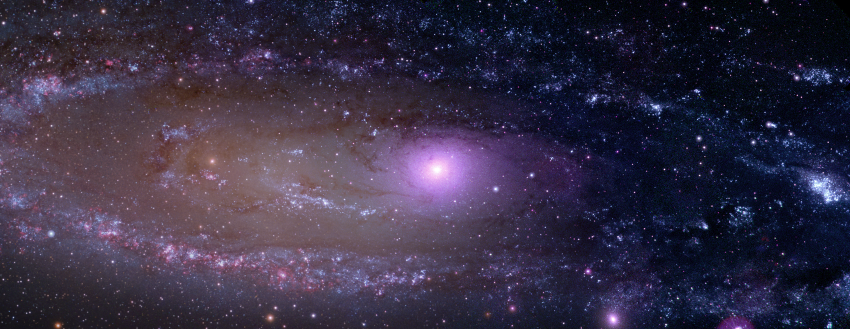** This talk is taking place at Royal Observatory Edinburgh, Blackford Hill, Edinburgh EH9 3HJ **
Book a Fellows April SDM In Person or Online ticket
Book a Non Fellows April SDM In Person or Online Ticket
The UV and near-UV wavelength range is key for exploring the origin of our universe and all its components, providing a wealth of diagnostic features critical for the study of solar system objects, stellar astrophysics, transient phenomena, galactic formation and evolution, or cosmology.
The next generation of ultra-sensitive UV missions or instruments, for which the UK astronomical community has shown a strong interest, are currently under design. This includes CUBES, a forthcoming spectrograph to be installed at the Cassegrain focus of one of the VLTs in 2027, covering the near-UV wavelength range (300 - 400 nm) at intermediate-high spectral resolution (R~20,000) with high efficiency.
The UK is a keypartner in CUBES, for both science and hardware. CUBES will provide access to over 30 iron-peak and heavy elements in stellar spectra and will also be instrumental for extragalactic observations, including cosmology, the circumgalactic medium of galaxies in the redshift range 1.5 < z < 2.8, and to infer the relative contributions of different types of galaxies/AGN to the cosmic UV background, among others.
The UK community has also shown a strong interest in joining the CASTOR mission. CASTOR is a Canadian-led space mission that will provide high-resolution imaging and low/intermediate resolution multi-object spectroscopy in the UV/optical spectral region (150-550 nm) over an instantaneous 0.25 deg2 field of view. CASTOR will provide a unique combination of sensitivity and wide field of view together with Hubble-like image quality. UK scientists are actively participating in the development of several key science cases (from solar system science to cosmology and transients), and negotiations are ongoing with the UK Space Agency for the UK to join the mission as full partners.
This meeting will focus on breakthrough science that will be enabled by these future UV facilities. It will provide an opportunity for the community to gather and share current developments regarding future UV missions and instruments, discuss UK involvement, synergies with other facilities such as Euclid and LSST, and enable crucial discussions to align the science being developed for these upcoming instruments to the UK strategic priorities. The meeting will also focus on discussing the longer term future of UV astronomy, including for example NASA’s LUVOIR telescope.
Abstract submission for our RAS meeting: https://forms.gle/
The Royal Observatory sits on top of a hill and there is no possibility to buy lunch from local eateries. However, a packed lunch can be ordered in advance of the meeting. It will contain a sandwich, a pack of crisps, a fruit piece, and a drink (vegan or gluten free options can also be provided on request).
Payment will be collected on-site on the day of the meeting. Lunch must be ordered by 04/04/2024 using the following link.
09:30 - 10h20: Networking and coffee.
10:20 - 10h30: Welcome/Logistics
10h30 - 11h30: Megan Ansdell, Martin Barstowm and Carolin Harper - Habitable Worlds Observatory
11h30 - 12h00: Cyrielle Opitom - The CUBES near-UV spectrograph
12h00 - 12h10: Colin Snodgrass - Japanese UV instrumentation (title to be confirmed)
12h10 - 12h25: Fatemeh Zahra Majidi - Mauve: a UV-Vis satellite dedicated to monitor stellar activity and variability
12h25 - 12h40: Ariadna Calcines-Rosario - Developments of the image slicer technology for UV and EUV applications
12h40 - 13h40: Lunch
13h45- 14h00: Samantha Oates - UV Observations of Gravitational Wave Events
14h00 - 14h15: Jamie Williams - Using ultraviolet spectroscopy of metal enriched white dwarfs to infer the composition of exoplanets
14h15 - 14h30: Sergio Humberto Ramirez - FUV Observations of the Evolved Cataclysmic Variable V3101 Cyg: The Extraordinary Case of a Low-Mass White Dwarf and its Substellar Companion.
14h30 - 14h45: Snehalata Sahu - UVEX
14h45 - 15h00: Thomas Haworth - The NASA Small Explorer concept Eos
15h00 - 15h30 : Patrick Cote - The CASTOR mission
15h30 - 16h00 Networking and coffee
16h00 - 18h00: A&G Highlight meeting
Invited speakers:
Prof Patrick Côté,
Prof Martin Barstow
Dr Cyrielle Opitom
Organisers:
Ruben Sanchez-Janssen (ROE)
Cyrielle Opitom (ROE)
Matt Nicholl
Ryan Cooke


